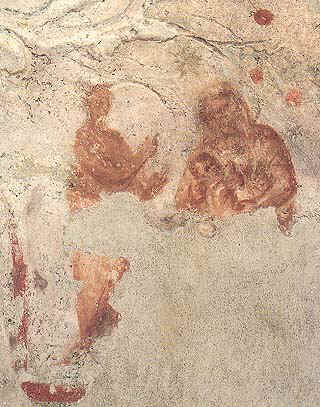Hi viewers, we are back with the 10th episode of Design culture which defines the different art forms and art culture developed from time to time all over the world which has contributed a lot to the design community and its development. In this episode we are going to see about Early Christian art which existed during the middle Ages i.e. after the birth A.D.
Early Christian art and architecture works of art exhibiting Christian themes and structures designed for Christian worship created relatively soon after the death of Jesus. Most date from the 4th to the 6th century A.D. This is the art and architecture produced for the united Christian church. This art extends over the Late Antique period, Roman art and architecture (the late 2nd – 7th century), and the Byzantine art and architecture (from 5th – 7th century).
Earliest Works
Little is known about Christian art in the first two centuries after the death of Jesus. Among the earliest manifestations extant are the early 3d-century paintings on the walls of the catacombs in Rome. Whereas the style resembles that of secular Roman wall painting, the subject matter consists mainly of biblical figures. Jonah, Daniel, and Susanna appear in scenes of miracles through divine intervention. Among the motifs that symbolized the hope of resurrection and immortality are the fish and the peacock. Following the official recognition of Christianity after the Edict of Toleration (313), the scope of Early Christian art was radically enlarged.
Mosaics and Manuscript Illumination
Elaborate mosaic narrative cycles covered the upper walls, triumphal arch, and apse of basilica churches (see basilica. Some are preserved in Santa Maria Maggiore and Santa Pudenziana in Rome and Sant’Apollinare Nuovo in Ravenna. The use of gold backgrounds heightens the effect of otherworldliness and transcendence. In contrast to paganism, the Christian faith was bound by the authority of sacred writings, and it placed increasing importance on the production of books and their illumination. Some fragments of the biblical text, written in silver and gold on purple vellum and sumptuously illuminated, are still preserved (see illumination). Foremost of these is the Vienna Genesis, a manuscript of the first half of the 6th cent.
Development of Early Christian art in Roman Empire
The Christian religion was part of a general trend in the late Roman Empire toward mysticism and spirituality. As Christianity developed, its art reflected the prevailing late antique artistic climate. Except for differences in subject matter, Christian and pagan works looked much the same; in fact, it is possible to show that the same workshop sometimes produced sculpture for both Christian and non-Christian purposes.
The earliest identifiably Christian art consists of a few 2nd-century wall and ceiling paintings in the Roman catacombs (underground burial chambers), which continued to be decorated in a sketchy style derived from Roman impressionism through the 4th century. They provide an important record of some aspects of the development of Christian subject matter. The earliest Christian iconography tended to be symbolic. A simple rendering of a fish was sufficient to allude to Christ. Bread and wine invoked the Eucharist. During the 3rd and 4th centuries, in the catacomb paintings and in other manifestations, Christians began to adapt familiar pagan prototypes to new meanings. The early figural representations of Christ, for instance, most often show him as the good shepherd by directly borrowing from a classical prototype. He was also sometimes depicted in the guise of familiar gods or heroes, such as Apollo or Orpheus. Only later, when the religion itself had achieved some measure of earthly power, did he take on more exalted attributes. Narratives tended at first to be typological, often suggesting parallels between the Old and New Testaments. The earliest scenes from the life of Christ to be depicted were the miracles. The Passion, particularly the Crucifixion itself, was generally avoided until the religion was well established.
The beginnings of Early Christian art date to the period when the religion was yet a modest and sometimes persecuted sect, and its flowering was possible only after 313, when the Christian emperor Constantine the Great decreed official toleration of Christianity. Subsequent imperial sponsorship brought the religion popularity, riches, and many converts from all classes of society. Suddenly the church needed to produce art and architecture on a more ambitious scale in order to accommodate and educate its new members and to reflect its new dignity and social importance.
Churches and shrines were soon being built throughout the empire, many sponsored by Constantine himself. These buildings were usually five-aisled basilicas, such as Old St. Peter’s in Rome, or basilican-plan buildings centring upon a round or polygonal shrine, such as that in the Church of the Nativity in Bethlehem. Large-scale sculpture was not popular, but relief sculpture on sarcophagi, such as that of Junius Bassus (died 359), and ivory carvings and book covers continued to be produced. The walls of the churches were decorated with paintings or mosaics to instruct the faithful. The church of Sta. Maria Maggiore in Rome has an extensive mosaic program of Old and New Testament scenes that was begun in 432. Painting also illustrated liturgical books and other manuscripts.
The art of this period had its roots in the classical Roman style, but it developed into a more abstract, simplified artistic expression. Its ideal was not physical beauty but spiritual feeling. The human figures thus became types rather than individuals and often had large, staring eyes, “the windows of the soul.” Symbols were frequently used, and compositions were flat and hieratic, in order to concentrate on and clearly visualize the main idea. Although the art of the period intentionally departed from earlier naturalism, it sometimes has great power and immediacy.
Early Christian Iconography
During the persecution of Christians under the Roman Empire, Christian art was necessarily and deliberately furtive and ambiguous, using imagery that was shared with pagan culture but had a special meaning for Christians. The earliest surviving Christian art comes from the late 2nd to early 4th centuries on the walls of Christian tombs in the catacombs of Rome, although from literary evidence there may well have been panel icons which, like almost all classical painting, have disappeared. Initially Jesus was represented indirectly by pictogram symbols such as the Ichthys (fish), peacock, Lamb of God, or an anchor (the Labarum or Chi-Rho was a later development). Later personified symbols were used, including Jonah, whose three days in the belly of the whale pre-figured the interval between Christ’s death and Resurrection, Daniel in the lion’s den, or Orpheus charming the animals. The image of “The Good Shepherd”, a beardless youth in pastoral scenes collecting sheep, was the commonest of these images, and was probably not understood as a portrait of the historical Jesus.[1] These images bear some resemblance to depictions of korus figures in Greco-Roman art. The “almost total absence from Christian monuments of the period of persecutions of the plain, unadorned cross” except in the disguised form of the anchor,[2] is notable. The Cross symbolizes Jesus’ crucifixion on a cross which was not represented explicitly for several centuries, possibly because crucifixion was a punishment meted out to common criminals, but also because it is clear from literary sources that it was a symbol recognised as specifically Christian, as the sign of the cross was made by Christians from very early on.
Image credits: www.ou.edu
















For many of the early Christian sailors, the dolphin was a symbol for Jesus. The attributes of the dolphins in folklore were attributed, and rightly so, to Jesus as the rescuer, savior of sailors, guide and of course, friend. As you might imagine, those who lived by the sea related much more to dolphins than sheep. And so, the dolphin naturally became a popular Christian image.
interesting read as always =)
you are right, Its intresting